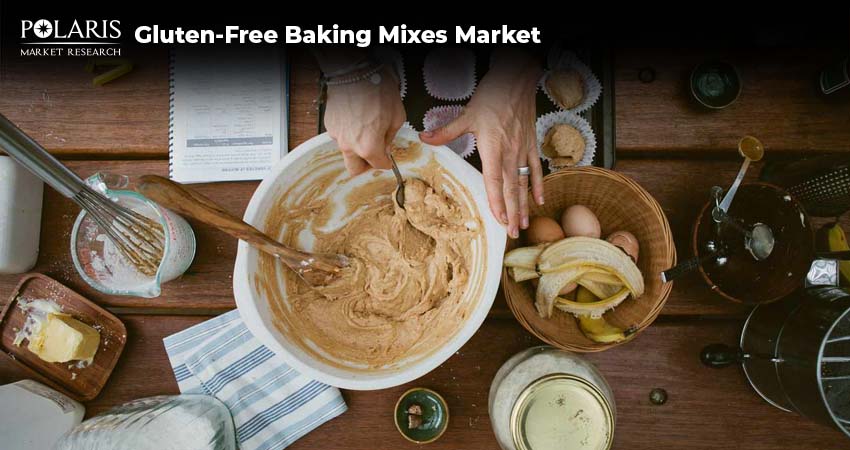Why Are Gluten-Free Baking Mixes a Staple in Modern Kitchens?

Gluten-free baking has come a long way over the past few years. Whether it’s managing celiac disease, gluten sensitivity, or simply exploring alternative diets, an essential kitchen staple can make all the difference: gluten-free baking mixes. After all, these pre-mixed blends simplify baking without sacrificing quality or texture.
In this blog post, we take you to the fascinating realm of gluten-free baking mixes. We explain to you the fundamentals of these baking mixes and their various types available on the gluten-free baking mixes market. In addition, we shed light on why gluten-free baking mixes are becoming increasingly popular among individuals globally. Let’s dive in!
What Are Gluten-Free Baking Mixes?
Before exploring to you what gluten-free baking mixes are, let’s have a look at some basics. Gluten is a protein found in wheat, barley, and rye. It is responsible for giving baked goods its structure and elasticity. With gluten, recipes can turn out dense, crumbly, or flat. Gluten-free baking mixes take the guesswork out of baking by offering a carefully balanced blend of flour and binders. These mixes are designed to mimic the properties of wheat-based flour, making them ideal for both beginners and experienced bakers looking for convenience.
With the continuous development of new product varieties, the demand for gluten-free baking mixes is witnessing sustained growth. The gluten-free baking mixes market size is projected to reach USD 1,046.17 million by 2034, at a CAGR of 7.59% during 2025–2034.
Types of Gluten-Free Baking Mixes
There are several types of gluten-free baking mixes. Each of these baking mixes is designed for different types of baked goods. Here’s a look at some of the most common ones:
Gluten-Free All-Purpose Baking Mix
This is one of the most versatile types of baking mix and serves as a staple in kitchens. Designed as a regular flour cup-to-cup replacement in most recipes, these mixes typically contain a blend of rice flour, potato starch, and tapioca starch. In addition, binding agents like xanthan gum or guar gum are also present. All of these ingredients work together to mimic the texture and elasticity offered by gluten. All-purpose baking mixes are ideal for cookies, muffins, pancakes, quick breads, and other bakery products.
Gluten-Free Cake Mix
Gluten-free cake mixes are specifically formulated to create soft, tender, and fluffy cakes without the need for gluten. These mixes often contain a finer blend of gluten-free flour like millet flour or white rice flour. In addition, they include cornstarch or tapioca starch that helps lighten the batter. Gluten-free cake mixes are balanced to hold together well while offering a moist crumb. This makes them suitable for layer cakes, cupcakes, and sponge cakes.
Gluten-Free Bread Mix
Gluten is responsible for giving bread its structure and chewiness. As a result, bread baking is one of the more challenging areas in gluten-free baking owing to the absence of gluten. Gluten-free bread mixes are specifically designed to help the dough rise and hold its shape. These mixes often include heavier flour like sorghum flour or teff flour. These flours are combined with starches and xanthan gum to provide texture. Some gluten-free bread mixes may also have added sugar to help activate yeast.
Gluten-Free Cookie Mix
Cookie mixes are created to offer chewy or crunchy textures that resemble traditional cookies but without gluten. These mixes typically include a combination of rice flour or oat flour, starches, sugar, and leaving agents. Some cookie mixes may need the addition of eggs and butter, whereas others are fully vegan. This combination of ingredients ensures that cookies spread properly and offer a satisfying bite.
Besides these, other gluten-free baking mixes include pancake and waffle mixes, muffin mixes, pizza crust mixes, and biscuit mixes.
Consumer Appeal for Gluten-Free Baking Mixes
A combination of factors shapes the popularity of gluten-free baking mixes market. Below, we’ve explained some of them:
Rising Health Consciousness and Medical Necessity
Individuals with celiac disease or non-celiac gluten sensitivity drive a significant portion of the demand for gluten-free products. This is because gluten-free items are a medical necessity for these individuals. Baking mixes provide these consumers with safe, easy-to-use alternatives to traditional flours and baking products. In addition, an increasing number of health-conscious consumers who don’t have a formal diagnosis perceive gluten-free products as healthier or lighter alternatives.
Convenience and Time-Saving
Baking from scratch with gluten-free ingredients can be complex owing to the need for precise ratios of alternative flours, scratches, and binders. Gluten-free baking mixes take away the need for this trial-and-error process, providing time-saving convenience and consistent outcomes. This makes them highly appealing to busy households, new bakers, and consumers without access to specialty ingredients.
Increased Usage in Foodservice Sector
Gluten-free menu offerings are being increasingly provided by foodservice and hospitality businesses to meet customer expectations and dietary needs. Gluten-free baking mixes play a crucial role in this context by offering standardized, scalable solutions that lower the risk of cross-contamination and inconsistent quality. Restaurants, institutional kitchens, and cafes often turn to baking mixes to streamline kitchen operations.
Rising Influence of Digital and Social Media
Social media platforms and influencer-led marketing have also played a role in driving the popularity of gluten-free baking at home. Recipe creators and food bloggers often showcase gluten-free baking mixes in use, which helps build product awareness and drive trial.
To Sum It Up
Gluten-free baking mixes have carved themselves a prominent niche in the modern kitchen. They are transforming the way individuals with gluten sensitivities and health-conscious consumers approach baking. As the need for inclusive and healthier food options continues to rise, the gluten-free baking mixes market provides a convenient, reliable, and delicious solution for home bakers and professionals alike.

